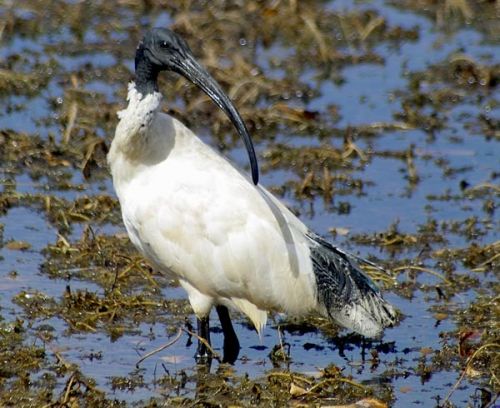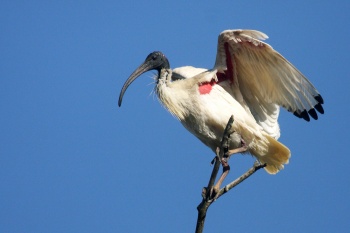(Add alternative name) |
|||
| (29 intermediate revisions by 7 users not shown) | |||
| Line 1: | Line 1: | ||
| + | [[Image:Australian_Ibis.jpg|thumb|500px|right|Adult, nominate subspecies<br />Photo © by {{user|julien|julien}}<br />[[Victoria]], [[Australia]], April 2004]] | ||
'''Alternative Name: Australian White Ibis''' | '''Alternative Name: Australian White Ibis''' | ||
| − | |||
;[[:Category:Threskiornis|Threskiornis]] molucca | ;[[:Category:Threskiornis|Threskiornis]] molucca | ||
| − | |||
==Identification== | ==Identification== | ||
| − | Bald black head and neck | + | [[Image:MG 1364mb.jpg|thumb|350px|right|Juvenile<br />Photo © by {{user|julien|julien}}<br />Ballarat, [[Victoria]], [[Australia]], 15 November 2007 ]] |
| + | 63–76 cm (24¾-30 in)<br /> | ||
| + | '''Adult''' | ||
| + | *Bald black head and neck | ||
| + | *White body | ||
| + | *Black feathers near tail | ||
| + | *Dark legs | ||
| + | *Red skin on underside of wing (during breeding) | ||
| + | *Long down-curved black bill<br /> | ||
| + | '''Juveniles''': head and neck are feathered. | ||
==Distribution== | ==Distribution== | ||
They are widespread in eastern and south western [[Australia|Australia]]. | They are widespread in eastern and south western [[Australia|Australia]]. | ||
==Taxonomy== | ==Taxonomy== | ||
This species was not too long ago thought to be a part of the [[Sacred Ibis]]. | This species was not too long ago thought to be a part of the [[Sacred Ibis]]. | ||
| − | + | ====Subspecies==== | |
| − | There are 2 subspecies. | + | [[Image:Australian Ibis2.JPG|thumb|350px|right|Adult<br />Photo © by {{user|Ken+Doy|Ken Doy}}<br />Sandy Camp Rd Wetlands, [[Queensland]], [[Australia]], 4 December 2016]] |
| + | There are 2 subspecies<sup>[[#References|[1]]]</sup>: | ||
| + | *''T. m. molucca'': | ||
| + | :*[[Australia]] to southern [[New Guinea]], southern [[Moluccas]] and eastern [[Lesser Sundas]] | ||
| + | *''T. m. pygmaeus'': | ||
| + | :*[[Solomon Islands]] (Rennell and Bellona) | ||
==Habitat== | ==Habitat== | ||
| − | + | Freshwater wetlands, irrigated areas, dams, floodplains, brackish and saline wetlands, tidal mudflats, pastures, lawns, orchards, garbage tips, public gardens. | |
==Behaviour== | ==Behaviour== | ||
| + | ====Diet==== | ||
The diet includes fish, frogs, insects and garbage. | The diet includes fish, frogs, insects and garbage. | ||
| + | ====Breeding==== | ||
| + | Colonial breeders, the breeding seasons is variable depending on the availability of water. | ||
| + | ====Vocalisation==== | ||
| + | [[Image:MG 5613mm.jpg|thumb|350px|right|Showing scarlet under-wing breeding patch<br />Photo © by {{user|julien|julien}}<br />Ballarat, [[Victoria]], [[Australia]], December 2014]] | ||
| + | Usually silent except around breeding colonies where they give a variety of harsh guttural croaks or honks; similar to calls of [[Straw-necked Ibis]] | ||
| + | ====Movements==== | ||
| + | Sedentary, dispersive. | ||
| + | ==References== | ||
| + | #{{Ref-Clements6thAug19}}#[http://animal.memozee.com/list.php?sec=BASIC&qry=australian+white+ibis Animal Pictures Archive] | ||
| + | #BirdForum Member observations | ||
| + | #Matheu, E., del Hoyo, J., Garcia, E.F.J. & Boesman, P. (2019). Australian Ibis (''Threskiornis moluccus''). In: del Hoyo, J., Elliott, A., Sargatal, J., Christie, D.A. & de Juana, E. (eds.). Handbook of the Birds of the World Alive. Lynx Edicions, Barcelona. (retrieved from https://www.hbw.com/node/52755 on 30 December 2019). | ||
| + | #de Boer L. E. M., van Brink J. M. (1982) Cytotaxonomy of the Ciconiiformes (Aves), with karyotypes of eight species new to cytology. Cytogenet Genome Res 34:19-34. | ||
| + | #Lowe, K. W.; Richards, G. C. (1991). Morphological Variation in the Sacred Ibis ''Threskiornis aethiopicus'' Superspecies Complex (PDF). Emu. 91 (1): 41-45. doi:10.1071/MU9910041. Retrieved 11 July 2018. | ||
| + | #Marchant, S.; Higgins, P.J. 1990. Handbook of Australian, New Zealand and Antarctic birds. Volume 1. Australian pelican to ducks. Oxford University Press, Melbourne. | ||
| + | #Schodde, R. & Bock, W. 2016. Conflict resolution of grammar and gender for avian species-group names under Article 31.2.2 of the ICZN Code: is gender agreement worth it? Zootaxa 4127: 161-170. | ||
| + | #Southey, I. 2013. White ibis. In Miskelly, C.M. (ed.) New Zealand Birds Online. [http://nzbirdsonline.org.nz/species/white-ibis www.nzbirdsonline.org.nz] | ||
| + | *[http://http://www.arthurgrosset.com/ozbirds/australianwhiteibis.html Arthur Grosset's Birds] | ||
| + | <br /> | ||
| − | + | {{ref}} | |
| − | |||
==External Links== | ==External Links== | ||
| − | {{GSearch|Threskiornis | + | {{GSearch|"Threskiornis molucca" {{!}} "Threskiornis moluccus" {{!}} "Australian Ibis" {{!}} "Australian White Ibis"}} |
| − | [[Category:Birds]] [[Category:Threskiornis]] | + | <br /> |
| + | {{VSearch|"Threskiornis molucca" {{!}} "Threskiornis moluccus" {{!}} "Australian Ibis" {{!}} "Australian White Ibis", video}} | ||
| + | {{GS-checked}}1 | ||
| + | <br /> | ||
| + | <br /> | ||
| + | |||
| + | [[Category:Birds]] [[Category:Threskiornis]] [[Category:Videos]] | ||
Latest revision as of 19:48, 7 April 2023
Alternative Name: Australian White Ibis
- Threskiornis molucca
Identification
63–76 cm (24¾-30 in)
Adult
- Bald black head and neck
- White body
- Black feathers near tail
- Dark legs
- Red skin on underside of wing (during breeding)
- Long down-curved black bill
Juveniles: head and neck are feathered.
Distribution
They are widespread in eastern and south western Australia.
Taxonomy
This species was not too long ago thought to be a part of the Sacred Ibis.
Subspecies
There are 2 subspecies[1]:
- T. m. molucca:
- Australia to southern New Guinea, southern Moluccas and eastern Lesser Sundas
- T. m. pygmaeus:
- Solomon Islands (Rennell and Bellona)
Habitat
Freshwater wetlands, irrigated areas, dams, floodplains, brackish and saline wetlands, tidal mudflats, pastures, lawns, orchards, garbage tips, public gardens.
Behaviour
Diet
The diet includes fish, frogs, insects and garbage.
Breeding
Colonial breeders, the breeding seasons is variable depending on the availability of water.
Vocalisation
Usually silent except around breeding colonies where they give a variety of harsh guttural croaks or honks; similar to calls of Straw-necked Ibis
Movements
Sedentary, dispersive.
References
- Clements, J. F., T. S. Schulenberg, M. J. Iliff, S. M. Billerman, T. A. Fredericks, B. L. Sullivan, and C. L. Wood. 2019. The eBird/Clements Checklist of Birds of the World: v2019. Downloaded from http://www.birds.cornell.edu/clementschecklist/download/
- Animal Pictures Archive
- BirdForum Member observations
- Matheu, E., del Hoyo, J., Garcia, E.F.J. & Boesman, P. (2019). Australian Ibis (Threskiornis moluccus). In: del Hoyo, J., Elliott, A., Sargatal, J., Christie, D.A. & de Juana, E. (eds.). Handbook of the Birds of the World Alive. Lynx Edicions, Barcelona. (retrieved from https://www.hbw.com/node/52755 on 30 December 2019).
- de Boer L. E. M., van Brink J. M. (1982) Cytotaxonomy of the Ciconiiformes (Aves), with karyotypes of eight species new to cytology. Cytogenet Genome Res 34:19-34.
- Lowe, K. W.; Richards, G. C. (1991). Morphological Variation in the Sacred Ibis Threskiornis aethiopicus Superspecies Complex (PDF). Emu. 91 (1): 41-45. doi:10.1071/MU9910041. Retrieved 11 July 2018.
- Marchant, S.; Higgins, P.J. 1990. Handbook of Australian, New Zealand and Antarctic birds. Volume 1. Australian pelican to ducks. Oxford University Press, Melbourne.
- Schodde, R. & Bock, W. 2016. Conflict resolution of grammar and gender for avian species-group names under Article 31.2.2 of the ICZN Code: is gender agreement worth it? Zootaxa 4127: 161-170.
- Southey, I. 2013. White ibis. In Miskelly, C.M. (ed.) New Zealand Birds Online. www.nzbirdsonline.org.nz
Recommended Citation
- BirdForum Opus contributors. (2024) Australian Ibis. In: BirdForum, the forum for wild birds and birding. Retrieved 19 May 2024 from https://www.birdforum.net/opus/Australian_Ibis
External Links
GSearch checked for 2020 platform.1







